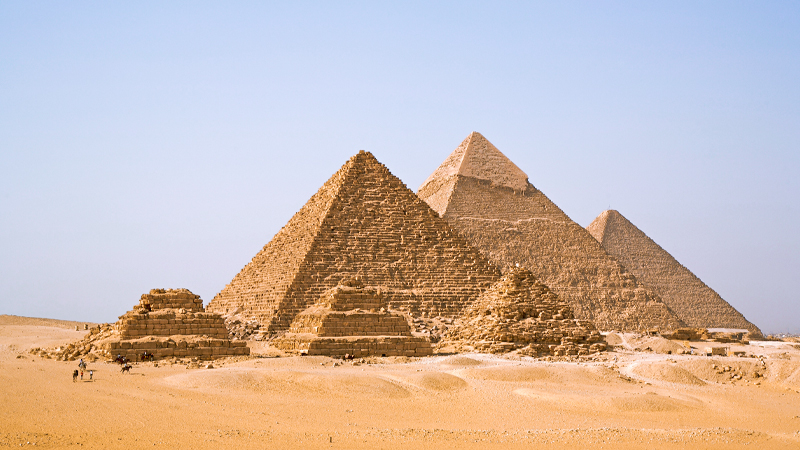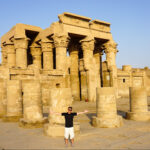Welcome to the captivating journey of the Great Pyramid of Cheops, also known as the Pyramid of Khufu, located on the Giza Plateau in Egypt. Standing tall as a testament to ancient Egyptian engineering brilliance, this awe-inspiring structure has captured the imagination of explorers, historians, and travelers alike for millennia. This article will delve deep into the fascinating world of the Great Pyramid, uncovering its historical context, construction techniques, enigmatic mysteries, and enduring significance.
The Historical Context of the Great Pyramid of Cheops

This section will explore the historical background and significance of the Great Pyramid of Cheops.
Ancient Egypt: A Civilization of Wonder and Majesty
Ancient Egypt, one of the world’s most remarkable civilizations, flourished along the fertile banks of the Nile River. It was a society characterized by monumental architectural achievements, intricate religious beliefs, and a profound reverence for the afterlife.
Pharaoh Khufu and His Ambitious Vision,
The Great Pyramid of Cheops was commissioned by Pharaoh Khufu, who ruled during the Fourth Dynasty of Egypt’s Old Kingdom. It is believed that Khufu’s reign marked a pinnacle in pyramid building, with his pyramid being the largest and most impressive.
Symbolism and Purpose
The pyramid served as a grand tomb for Pharaoh Khufu, intended to safeguard his body and worldly possessions for eternity. Additionally, it reflected his divine authority and served as a powerful symbol of Egypt’s wealth and influence.
The Ingenious Construction Techniques

Here, we will examine the remarkable engineering and construction methods used in building the Great Pyramid of Cheops.
Massive Stone Blocks and Their Transport
The pyramid uses enormous limestone blocks, some weighing as much as 50 tons. The mystery of how these colossal stones were transported from quarries to the construction site intrigues researchers.
Precision in Alignment and Symmetry
Despite its massive size, the pyramid displays astonishing precision in alignment and symmetrical design. Its sides are oriented to the cardinal points with remarkable accuracy.
Role of Skilled Labor and Organization
Building the Great Pyramid required a vast workforce of skilled laborers, engineers, and architects. The organization and management of such an ambitious project were a testament to ancient Egypt’s administrative capabilities.
Unraveling the Mysteries of the Great Pyramid of Cheops

This section will explore some intriguing mysteries and speculations surrounding the Great Pyramid.
- The Pyramid’s Hidden Chambers Over the centuries, explorers and archaeologists have discovered hidden chambers within the pyramid. From burial chambers to sections with unknown purposes, these spaces continue to captivate researchers.
- Alignment with Cosmic Forces Some researchers propose that the Great Pyramid was aligned with astronomical precision, pointing to specific celestial phenomena. Theories abound on its possible connection to the stars and the ancient Egyptian belief in the afterlife.
- The Enigma of Construction Techniques Despite extensive research, the exact techniques used to construct the pyramid remain a subject of debate and fascination. Theories range from the use of ramps to advanced lifting systems.
The Enduring Significance and Legacy
This section will explore the ongoing influence and legacy of the Great Pyramid of Cheops.
- The Influence on Ancient and Modern Architecture The Great Pyramid has left an indelible mark on architectural history. Its design and engineering principles have influenced structures throughout history, even inspiring modern architecture.
- Cultural and Spiritual Importance The pyramid’s significance extends beyond engineering and architecture. It holds immense cultural and spiritual importance for the people of Egypt and continues to symbolize national pride.
- Tourism and Exploration As one of the Seven Wonders of the Ancient World, the Great Pyramid draws millions of tourists annually. Its enigmatic allure fuels the curiosity of explorers and adventurers from all corners of the globe.

FAQs about the Great Pyramid of Cheops
What Is the Age of the Great Pyramid?
The Great Pyramid of Cheops is estimated to have been built around 2560 BCE, making it over 4,500 years old.
How Was the Great Pyramid Constructed Without Modern Technology?
The pyramid’s construction involved an immense labor force, ingenious engineering, and precise planning. Ramps and counterweights were likely used to move the massive stones into position.
Why Is the Pyramid Also Known as the Pyramid of Khufu?
The pyramid is named after Pharaoh Khufu, who commissioned its construction.
Are There Secret Chambers Yet to Be Discovered?
While some hidden chambers have been discovered, there is ongoing speculation that more may exist within the pyramid.
What Makes the Great Pyramid So Special Among Egyptian Pyramids?
The Great Pyramid is the largest and oldest of the three pyramids on the Giza Plateau, making it a unique and iconic structure.
Is It Possible to Enter the Great Pyramid?
Yes, the pyramid is open to tourists, and visitors can explore its interior, including the burial chamber.
Conclusion
The Great Pyramid of Cheops is a testament to ancient Egyptian civilization’s ingenuity, craftsmanship, and vision. Its monumental presence on the Giza Plateau continues to awe and inspire, leaving us with enduring mysteries and an appreciation for the remarkable achievements of our ancestors. As we continue to uncover its secrets, the Great Pyramid remains a timeless symbol of human achievement and a beacon of cultural heritage.




